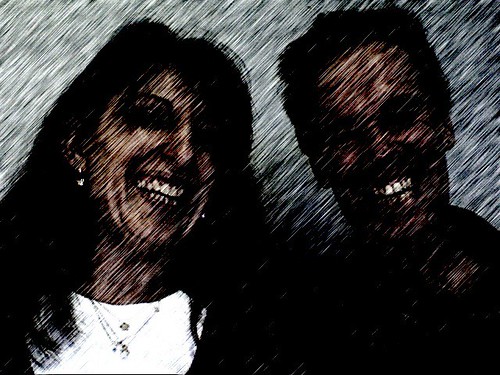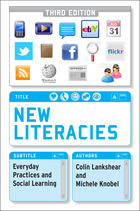Tuesday, July 15, 2008
Literacy and identity in virtual Worlds
How we see childhood, education and “growing up” depends on our theoretical lens. Guy discusses the rise of the sociocultural view of children and the increasing attention to the significance of interaction and networking.
There are at least two options available to us in terms of thinking about the internet and everyday life: To go the route of security—lock-stepped curriculum, filters etc. The other option is distributed learning that is open, fluid and interactive. This second position shapes Guy’s own position.
Guy shows us Google’s new Lively virtual world, and speaks about how identity is tied up with what the producers make
A virtual world is "an online space you feel as if you're there" (Schroeder 2002). Markham, in "Life Online", talks about the internet in three ways: the internet as a tool, the internet as a place, and the internet as a way of being. An online space, usually with the look of three dimensions, where you can move about and some sense of "network effect" (i.e., to interact in different ways with others). Some virtual worlds allow you to customize spaces, too (e.g., upload videos, build things).
Guy talks about a range of popular virtual worlds:
- Moove online--an avatar chat-based space.
- Moshi Monsters--an online virtual pet. (From the creator of Firebox - which sells things like rocket flares, star trek specs, i-sizebot "size is everything" which does absolutely nothing except sit on your desk and blink...)
These are examples of the "tools to hand for meaning making". A large percentage of school students are inhabiting these kinds of virtual worlds.
A brief history of virtual worlds for children:
1993 - CitySpace
1995 - Neopets
2000 - Habbo Hotel
2004 - Ketnetkick
2005 - Virtual Magic Kingdom
2005 - WebKinz
2007 - Club Penguin
2007 - Nicktropolis
2008 - Moshi Monsters
2008 - Adventure Rock
2008 - My Tiny Planets
2009 - Lego World
Market research strongly suggests that 10 year-olds are the fastest growing "markets" for virtual worlds.
Guy presents an analysis from a study that categorises child users into a range of types:
- Self stampers
Interested in presenting themselves to the world
likely to be both genders, possibly older children - Social climbers
Interested in status, ranks and competing with others - Collectors consumers
Interested in accumulating anything of perceived value, interested in gift exchange - Life system builders
Interested in creating new land, constructing something, want to create a system - Power users
Interested in giving everyone the benefit or yet knowledge and experience; likely to be experts within the game/space - Explorers and fighters
Interested in solving a quest, solving a mystery, going on a journey, being "outdoors" - Fighters
Interested in death and destruction, although most virtual worlds online don't include opportunities to kill things.
Nurturers
Guy asks, given all this, what use of these virtual worlds can or should we make with these virtual worlds?
Guy introduces us to his case study of "Barnsborough"--a virtual world project involving students, children and programmers. The world itself is located within "Active Worlds". The aims of this study include:
- to explore the digital literacy and the educational potential of virtual world gameplay
- to develop a literacy=rich 3D virtual world which children can explore in avatar-based geography
- to enhance boys literacy (paying attention to local and national concerns etc.)
Participants included at the start 10 schools (now 15) and students aged 9-11 years. the planning group comprised local literacy and drama specialists, ICT advisory staff, primary school teachers and myself as consultant and researcher. The development company was virtually Learning, which is based in Finland.
Barnsborough
- a number of interconnected zones which are life-like and familiar
- town, complete with streets, alleyways, cafes, shops and administrative buildings
- park with a play area, bandstand, boating lake, mansion, woodland and hidden caves
- residential area, industrial zone
The "brief" upon entering this world is that the previous inhabitants of Barnsborough have disappeared and your task is to work out why.
The interface includes rich media, tool-tip clues (e.g., "The room apepars to have been trashed"), hyperlinked and downloadable texts. Different possible scanerios are hinted at: major bio-hazard issue (barrels lying around and polluting a local lake), alien abduction scenario, a political or big business disaster, or suggest something more mysterious (e.g., Big Brother).
In all, Barnsborough comprises a "constellation of literacy practices" -- chat functions, clues posted around the world, videos etc.
Research issues
- What's real?
- Inter-related social worlds (the cultural worlds that the kids inhabit in the physical world, the cultural world of the school within which their doing this stuff, then the cultural world of the virtual world they log into)
- how to document this - had the opportunity to be "invisible" so that he could listen in on conversations, but declined this ability and interacted more explicitly with his study participants
- observation and disruption
- classroom visits, avatar interviews (conducted in-world), planning documentation, artifacts and fieldnotes
Guy displays some of his conversation/interview data and discusses some of the conventions they use that signals their understanding of how conventional print literacy works (the students are typing their speech).
Tensions
- What adults think children will like (which rarely matches what they *do* like)
- Building a "unified social world" (Pratt 1991) - which is often the unspoken goal of teachers
- Creating and controlling (the environment (e.g., faux country-life nostalgia vs urban dystopia; participating teachers wanting to stop kids' avatars from flying because they would be "out of control" or "fly off anywhere")
Transgression
The students' and teachers' discussions of their avatar experience proved to be particularly interesting to Guy.
Overall observations
- The children and teachers find it a highly motivating environment
Issues
- virtual worlds invite us to re-examine our identities and interactions
- what sorts of learning environments do we imagine
- digital literacy destabilises
- (for teachers) as control slips away...
Wrap-up
Students are well-aware that literacy is being "done to" them in schools. they understand that progress is measured by individual results on test scores. they *also* are aware of the dissonances (e.g., trying to pick up guns as in games, escping from the town). The teachers replicate traditional classroom practices inside this virtual world, but it doesn't have to be that way. Virtual places like Barnsborough offer all sorts of real opportunities for exploring alternatives.
Labels: identity








